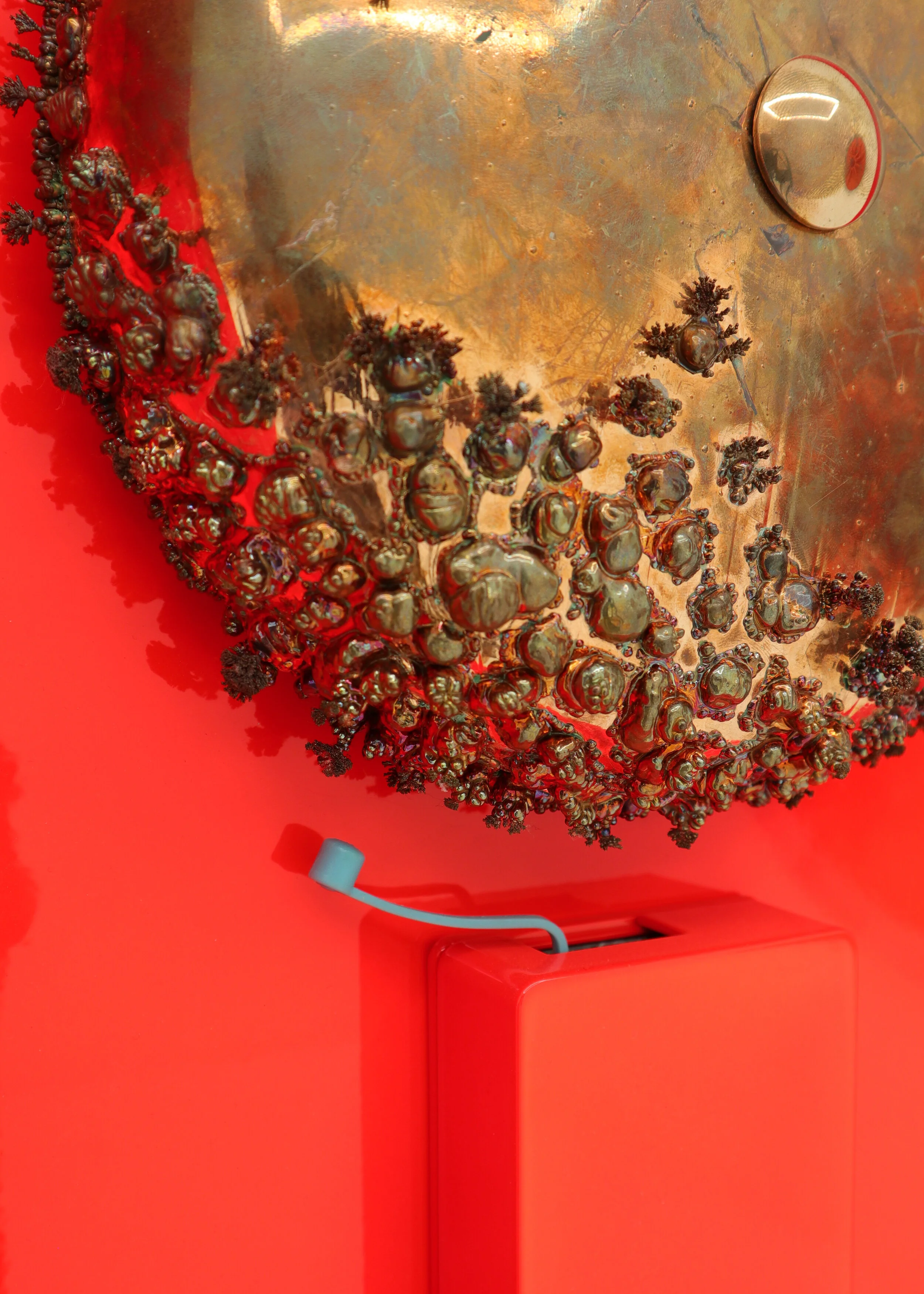




















Your Custom Text Here
December 1st, 2019–January 9th, 2020
Opening Sunday, December 1 from 6-9 PM
Today’s space-race stories are recapitulations of colonial projects, masked as solutionism and utopic migration. The first world dreams of new extractive frontiers and their futures of terraformed, air-locked enclaves are unevenly distributed.
They split the atmospheres of the privatized and are selectively fertilized from the extracted and exhausted. As much as they are aggregates of particles and molecules, these atmospheres are imaginaries—moods at social scale, narrative bubbles enveloping populations. Modeling these enclosures, Stragglers stages its architecture as a closed circuit of respiration and emission. Predictive scents are piped into and diffused in one space; sucked out and exhausted in another. The building is an organ constantly exhaling and inhaling, producing and dumping.
Silos
Initiated as a collaborative research laboratory, the International Space Station (ISS) now acts as an outpost for the commercialization of outer space. Sustaining the longest, continuous human presence off earth since its launch in 1998, the station is a life support system for its inhabitants. Generating its own oxygen, the ISS tests how biotic processes grow, regenerate or fail in other habitats. The entry and exit into the closed world of the ISS is a pressurized airlock which separates the hospitable from the inhospitable. Like the Global Seed Vault in Svalbard, Norway, the station is a bunker where the reproduction of life is sealed and suspended. Though ostensibly sealed, both spaces are subject to leakage, contaminants, and unseen exchanges. After the “Old World” brought it’s diseases with its crops to the “New World” in the Columbian Exchange, the skin and hair particles of astronauts clogged NASA’s early space simulators. Using air-flow software that renders how oxygen fills volumes, Silos presents the airlock as a similarly unstable architecture, a body that is not sterilized and static but instead subject to deflation and unmanaged life.
Stressors
Limp hammers struggle to strike deformed alarm bells, which have been overfed with electricity and minerals. The gears slowly turn but the warped physics of the mechanism fail to generate a sound. Framed in the high-visibility colors of ambulances, the emergency of the alarm is muted, incessant and normalized.
Ideopaths and Extremophiles
While it usually burrows deep into the human body, an endoscopic camera travels in Ideopaths and Extremophiles through a series of architectural arteries and clogged infrastructures—air conditioner filters, shower drains, electrical conduits, car engines. Excerpts skimmed from online medical forums of self-diagnosed conditions with unknown causes trail through the passages. They speak of insides projected onto space and speculate on environmental factors at the microbial level. Reshuffling causalities and scales, perceptions and prognoses, access or denial of care orients one’s semiotic world.
Pollinators
Air-borne particles both fertilize and choke atmospheres: pollen travels from flowers’ stamens to other flowers; brake pads and tires grind into a micro-dust that diffuses past the roads they travel. Volatile compounds bind to the senses. Smell is the perception of this traffic.
Synthesized from petroleum, formed into tires, worn out and then recycled into a colored gravel for landscaping—rubber, is one of these traveling particulates. Like many polymers, it moves from the planet’s bowels to its top layer, circulating and accumulating. In its recycled form, it’s meant to resemble mulch and fertilizer. Some call this green. Playgrounds and landfills are typically surfaced with these squishy, compacted bits.
Cooper Jacoby (b.1989) lives and works in Los Angeles. His solo exhibitions include Susceptibles, High Art, Paris (2018); Disgorgers, Swiss Institute at the LUMA Foundation, Zurich (2017); Bait, Freedman Fitzpatrick, Los Angeles (2017); and Matte Wetter, Staatliche Kunsthalle Baden-Baden (2016). Jacoby has participated in group exhibitions at FRAC Ile-de-France, Paris (2019); Villa Datris, l’Isle-Sur-La-Sorgue (2019); Swiss Institute, On-Site, New York (2019); KW Institute for Contemporary Art, Berlin (2015); and Neuer Aachener Kunstverein, Aachen (2015).
Stragglers is his first solo exhibition at CENTRAL FINE, Miami Beach.
December 1st, 2019–January 9th, 2020
Opening Sunday, December 1 from 6-9 PM
Today’s space-race stories are recapitulations of colonial projects, masked as solutionism and utopic migration. The first world dreams of new extractive frontiers and their futures of terraformed, air-locked enclaves are unevenly distributed.
They split the atmospheres of the privatized and are selectively fertilized from the extracted and exhausted. As much as they are aggregates of particles and molecules, these atmospheres are imaginaries—moods at social scale, narrative bubbles enveloping populations. Modeling these enclosures, Stragglers stages its architecture as a closed circuit of respiration and emission. Predictive scents are piped into and diffused in one space; sucked out and exhausted in another. The building is an organ constantly exhaling and inhaling, producing and dumping.
Silos
Initiated as a collaborative research laboratory, the International Space Station (ISS) now acts as an outpost for the commercialization of outer space. Sustaining the longest, continuous human presence off earth since its launch in 1998, the station is a life support system for its inhabitants. Generating its own oxygen, the ISS tests how biotic processes grow, regenerate or fail in other habitats. The entry and exit into the closed world of the ISS is a pressurized airlock which separates the hospitable from the inhospitable. Like the Global Seed Vault in Svalbard, Norway, the station is a bunker where the reproduction of life is sealed and suspended. Though ostensibly sealed, both spaces are subject to leakage, contaminants, and unseen exchanges. After the “Old World” brought it’s diseases with its crops to the “New World” in the Columbian Exchange, the skin and hair particles of astronauts clogged NASA’s early space simulators. Using air-flow software that renders how oxygen fills volumes, Silos presents the airlock as a similarly unstable architecture, a body that is not sterilized and static but instead subject to deflation and unmanaged life.
Stressors
Limp hammers struggle to strike deformed alarm bells, which have been overfed with electricity and minerals. The gears slowly turn but the warped physics of the mechanism fail to generate a sound. Framed in the high-visibility colors of ambulances, the emergency of the alarm is muted, incessant and normalized.
Ideopaths and Extremophiles
While it usually burrows deep into the human body, an endoscopic camera travels in Ideopaths and Extremophiles through a series of architectural arteries and clogged infrastructures—air conditioner filters, shower drains, electrical conduits, car engines. Excerpts skimmed from online medical forums of self-diagnosed conditions with unknown causes trail through the passages. They speak of insides projected onto space and speculate on environmental factors at the microbial level. Reshuffling causalities and scales, perceptions and prognoses, access or denial of care orients one’s semiotic world.
Pollinators
Air-borne particles both fertilize and choke atmospheres: pollen travels from flowers’ stamens to other flowers; brake pads and tires grind into a micro-dust that diffuses past the roads they travel. Volatile compounds bind to the senses. Smell is the perception of this traffic.
Synthesized from petroleum, formed into tires, worn out and then recycled into a colored gravel for landscaping—rubber, is one of these traveling particulates. Like many polymers, it moves from the planet’s bowels to its top layer, circulating and accumulating. In its recycled form, it’s meant to resemble mulch and fertilizer. Some call this green. Playgrounds and landfills are typically surfaced with these squishy, compacted bits.
Cooper Jacoby (b.1989) lives and works in Los Angeles. His solo exhibitions include Susceptibles, High Art, Paris (2018); Disgorgers, Swiss Institute at the LUMA Foundation, Zurich (2017); Bait, Freedman Fitzpatrick, Los Angeles (2017); and Matte Wetter, Staatliche Kunsthalle Baden-Baden (2016). Jacoby has participated in group exhibitions at FRAC Ile-de-France, Paris (2019); Villa Datris, l’Isle-Sur-La-Sorgue (2019); Swiss Institute, On-Site, New York (2019); KW Institute for Contemporary Art, Berlin (2015); and Neuer Aachener Kunstverein, Aachen (2015).
Stragglers is his first solo exhibition at CENTRAL FINE, Miami Beach.